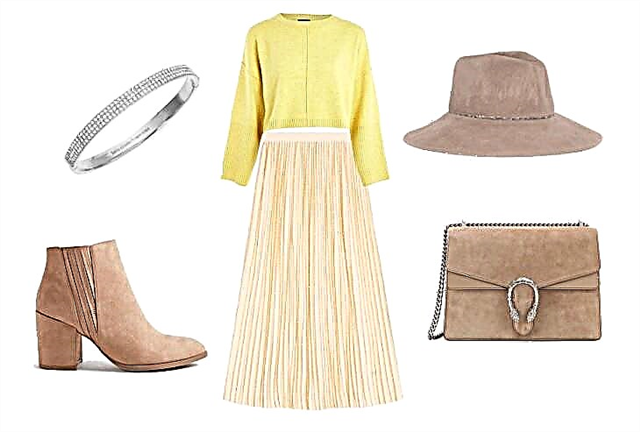In this master class, we will show how to change the pattern of a bodice with a set-in sleeve and create a feminine silhouette with a lowered shoulder and a “flashlight” sleeve.

As a basis for modeling, I chose a dress pattern with a tight bodice No. 121 from Burda magazine 11/2012.
- Best-seller
- Special offer

- 1
- 2
- 3
- 4

Before proceeding to modeling, it is necessary to prepare the basic pattern of the bodice: copy from the sheet of patterns or print, make the necessary adjustments to the figure and cut out the pattern.
In addition, you will need:

- tracing paper;
- pencil or marker;
- paper scissors;
- ruler;
- masking tape;
- The pattern is "drop";
- The pattern is "saber."
Modeling a sleeve with drapery and a cutout on the shoulder
Step 1


Cover the finished parts of the shelf and back with tracing paper and fix with weights or masking tape.
Step 2

Let's start with the neck. If it is necessary to adjust its width, then we retreat the desired value along the shoulder line. I decided to expand the neck by 2 cm.
Step 3

We outline the shoulder line and extend it by 5 cm.
Step 4

From the elongated shoulder line, lower the perpendicular and set aside 2 cm along it.
Step 5

We note two points in the drawing: the end of the old shoulder line is point A, the end of the new shoulder line is point B. Connect the points A and B with a straight line, and then draw it with a curved line using a piece.
Step 6

From point B, lower the perpendicular to the new shoulder line so that it abuts the armhole. Let us draw the resulting segment with a concave line.
We outline the resulting detail of the shelf, taking into account the new construction lines of the neck, shoulder and armhole.
Step 7

Let's move on to modeling the back. From the neck along the shoulder line, we postpone the necessary distance to increase the neck. I set aside 2 cm.
We model a sleeve "bishop"
Step 8

We outline the shoulder line and extend it by 5 cm.
Step 9

From the elongated shoulder line, lower the perpendicular and set aside 2 cm along it.
Step 10


We note two points in the drawing: the end of the old shoulder line is point A, the end of the new shoulder line is point B. Connect the points A and B with a straight line, and then draw it with a curved line using a piece.
Step 11



From point B, lower the perpendicular to the new shoulder line so that it abuts the armhole. Let us draw the resulting segment with a concave line. The location of the remaining section of the armhole corresponds to the original drawing.
Step 12

If necessary, we simulate the neck of the back.
I decided to make a shallow triangular neckline on the back. To do this, in the center of the back I lay down the selected cut-out depth - 17.5 cm, point B. I connect the points A and B in a straight line and draw it with a slightly concave line using a piece.
Step 13

We outline the resulting detail of the shelf, taking into account the new construction lines of the neck, shoulder and armhole.
If after the actions taken the armhole has become shorter, lower the armhole line (green dotted line in the photo) by 1.5–2 cm along the side seam of the bodice.
Now the details of the shelf and back can be cut. Their modeling is completed.
Step 14

Let's move on to modeling sleeves. We cover the finished part of the sleeve with tracing paper and fix it with weights or masking tape.
Modeling Tulip Sleeves
Step 15

We put the finished back detail on the sleeve pattern and correlate the length of the armhole to the bend and the line of the back of the sleeve ridge. The length of the outlined line of the ridge to the point, A in the drawing corresponds to the length of the armhole of the back to bending.
Step 16

We will do the same with the front part: the length of the outlined line of the front part of the ridge to point B in the drawing corresponds to the length of the armhole of the shelf before bending.
We also transfer the label of the combination of the sleeve and the shelf.
Step 17

Let’s drop the top of the okatka by 5 cm (since we lengthened the shoulder line by 5 cm) - point B.
Step 18

Connect the points A and B, B and B with smooth curved lines with the help of a pattern.
Step 19

We outline the resulting detail of the sleeve, taking into account the new design lines of the ridge.

You can perform verification actions: the length of the front of the sleeve ridge must match the length of the armhole of the shelf, and the length of the back of the sleeve ridge must match the length of the armhole of the back.
Full-cut neckline and armhole in a sleeveless dress
Step 20

It remains to simulate the sleeve, "flashlight". To do this, on the drawing of the sleeve, draw several lines perpendicular to the bottom of the sleeve, dividing the pattern of the sleeve into several vertical stripes. We cut the pattern in vertical lines.
Step 21

On the fabric, the resulting vertical details must be distributed at an equal distance from each other, I spread them 3 cm. We outline the top of the resulting sleeve details using the “saber” pattern.
Note

If you want the sleeve to be more magnificent from below, then you need to push a little more from below than from above.

Simulation completed. To make sure that the bodice sits exactly as it was planned, it is better to stitch the layout.
Have a nice simulation!
The author of the master class and photo: Daria Tabatchikova

By education, Daria is a PR specialist and economist, but several years ago she devoted herself entirely to her favorite business - sewing.
She learned to sew from magazines, books and using the Internet, there are also sewing courses in the arsenal, but Daria considers herself to be self-taught. She loves to study specialized sewing literature from different years and countries, and then put her knowledge into practice.
At the end of 2017, Daria became the winner of the festive contest from BurdaStyle.ru.
She leads her Instagram page and VKontakte group.
Material prepared by Julia Dekanova



